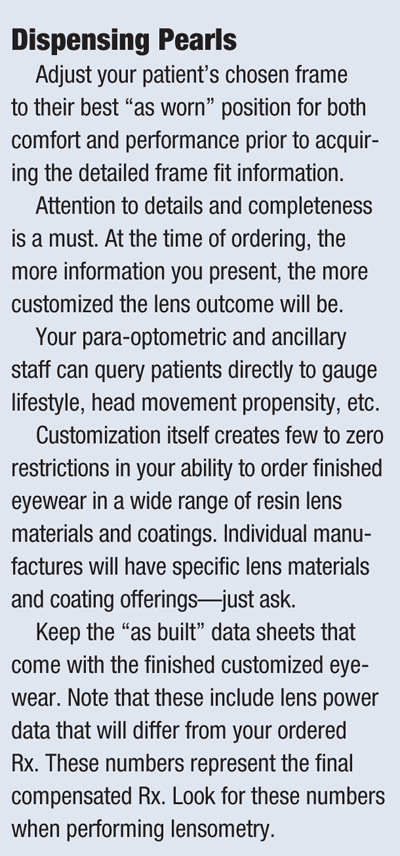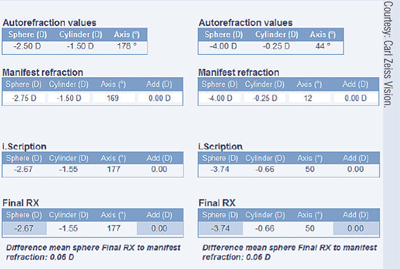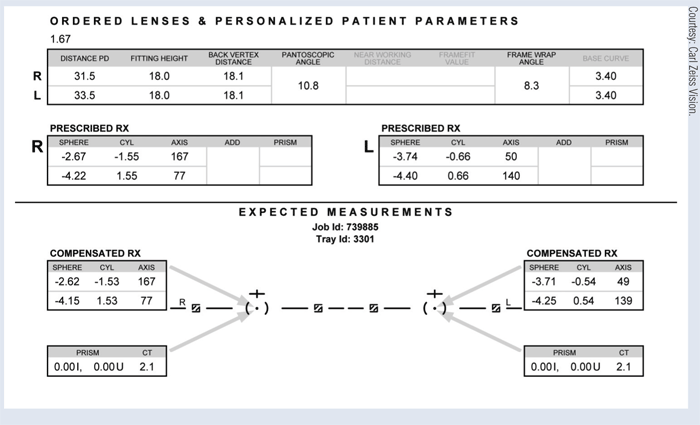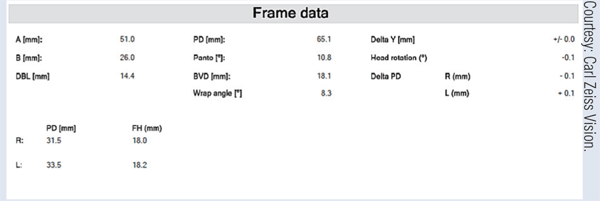As both a practicing optometrist and a trained optician, I have had the opportunity to travel and meet many professionals in the ophthalmic community. Over the years, refraction and eyewear both have proven to be satisfying and essential components of my day-to-day practice. Evolving technologies make it even more exciting. Refractive analysis and personalized prescribing have allowed me, with more and more certainty, to prescribe eyewear solutions that work for each and every patient I see.
In this article, I will focus on one area—the concept of individually customized lenses. This is not a new concept but it’s one that I sense has yet to fully take off as the standard of care in providing what I call exceptional end-point eyewear modalities.
The Rx Conundrum
“Writing for what you want” is a movement in the eye care profession that puts the onus on doctors to prescribe specific eyewear features including lens designs, materials, thicknesses, coatings, etc. But in most cases, practitioners leave this area of the Rx open.
When challenged to specify an order for your most appropriate progressive addition lens, at the very least, an uneasy pause occurs. You find yourself faced with too many options and choices. So, like most practitioners today, you opt not to scribe a specific lens option. You place your signature on the Rx, hand it off to the patient and let someone else decide how to interpret your cryptic recommendations. Is that really how you want to care for your patient?
Imagine this scenario: You have just completed another perfect refractive analysis session and now it’s time to “write for what you want” and “what your patient needs.” Using a combination of careful consideration, knowledge and experience, you have no problem penning a series of signs and numbers that comprise your final Rx. That’s exactly where many problems begin.
With so many lens choices available on the market, it is easy to understand why you might feel overwhelmed with the potential lens options. But in doing so, you are allowing someone else to act on what they think you were thinking.
A New World of Ophthalmic Lenses
So what’s the solution to this uncomfortable dilemma? In my experience, the first step to bridging the great divide is to simply write “Individually Customized Progressive or Single Vision Lens” in the comment/recommendation section of your Rx. By making this recommendation, you have prescribed the patient a form of vision correction that incorporates the most innovative ideas our industry has to offer. I am certain patients you have seen today would benefit from a uniquely customized, individually fabricated ophthalmic lens.
We walk through trade shows, spending time with well educated, technically proficient product representatives of all the major lens manufacturers. We read and have immediate access to a plethora of net-based information about the newest, best and greatest ophthalmic products and materials. But when we are asked to “write for what we want” with greater specificity, we don’t.
When our patient comes to see us, we focus on his or her vision care needs and much is shared during that time together. We ask questions and the patient presents his or her perspective and needs. Yet, when it comes to prescribing customized solutions, many of us prescribe a lens that contains many design compromises.
When we craft a pharmaceutical Rx, do we say, “Just the average drug will do?” Do we not agonize over all of the possibilities including effectiveness, availability, ease of use, compliance and end point goal, providing very specific instructions? Why should ophthalmic lens selection be any different? Remember, a finished lens Rx is still a prescription that ultimately represents you and your practice.
Inner Workings of Lens Customization
The current concept of customization and individualization emanates from the development of an enabling technology called free-form manufacturing. It is a computer-driven surface generator that employs a single-point diamond-cutting tool that can apply virtually any series of sophisticated curves to an unfinished resin lens puck. This technology creates a platform for which lenses can be customized.
But individualized lenses take this to the next level. When free-form generators are driven by a unique lens software package, this enabling technology produces truly customized lenses. It is being used extensively today in surfacing labs. In my opinion, in the very near future, most non-commodity based lens designs will be manufactured employing this technology. Customization permits limitless design variation, so designing for average values is no longer necessary. Just call your lab and ask them how free-form manufacturing has affected the way they do business.
Customization by Rx
Progressive addition eyewear continues to be somewhat of a confusing marketplace. Some say there are too many options, too many choices and too many high-risk decisions to make. We must simplify this process to offer lenses that incorporate the newest and best in design and manufacturing.
Like most new technologically driven products, customization has assumed a premier position in the ophthalmic lens pricing market. Practitioners, patients and insurance companies will ultimately determine the value of these products. As practitioners we must understand and appropriately recommend the best solutions to each and every patient. Let’s take a closer look at the areas of customization:
• Rx. Personalized lenses are individually crafted from a seemingly infinite number of lens base curve options. Having these options at their fingertips, the optics designers can craft a unique series of curves for every Rx, including sphere, cylinder and axis. Classic semi-finished blanks are available in a small number of base curves. Due to that limitation on most prescriptions, compromises have to be made with a net result of less-than-optimal outcomes due to residual optical aberrations. These compromises can result in smaller, odd shaped, uncomfortable viewing areas. When you customize by Rx, you offer patients excellent visual performance across the entire prescription range.
• “As worn.” This term refers to accounting for real-life conditions. Back vertex distance, pantoscoptic tilt and frame wrap angles have known effects on lens effective power. Variations in these parameters create unwanted sphere and cylinder power. Classic lens designs attempted to deal with this issue by manipulations of components of the optics by incorporating compensations for “average” amounts of vertex, panto and wrap. Average can sometimes be good but it is never exceptional. Customized lenses work by compensating lens power for the way a frame fits on your patient’s face. The benefit of lenses customized by “as worn” is increased visual acuity.
• Frame height. Short “B” dimension frames pose challenges to optimal visual outcomes for intermediate and near. To that end, every manufacturer has produced a short corridor progressive design. We are often forced to compromise by choosing an available progressive lens option that, by design, comes close to the actual fitting height we measure.
Customized lenses can be optimized for a wide range of fitting heights. Benefits of lenses customized by “frame height” are maximized for intermediate corridor widths, less intermediate peripheral blur and wider near zones.
Here’s how you can taylor ophtthalmic lenses with each patient’s lifetyle in mind:
• Seeking balance. Due to their uniqueness, personalized progressive designs can shift the emphasis within a particular lens to meet a patient’s specific task-oriented visual requirement. Using essentially one base lens design, optics designers can create enhanced distance, intermediate and reading zones. Benefits of lenses customized by life style are wider reading zones for near tasks or wider distance peripheral zones for active wearers.
• Head movement. It is well know that “eye turners” prefer lenses designed with wide fields of view and “head movers” have been forced to compromise the wider fields of view for “softer” lens designs. All this is done to decrease unwanted swim effects. Customized lenses can be adjusted to take into account your patients’ ergonomics. When you incorporate this customization, you offer patients optimized peripheral field utility.
• Single vision. Customization is not exclusively restricted to progressives. Due to similar lens design and manufacturing limitations, single vision users can suffer compromised visual outcomes. Lack of clarity in peripheral viewing zones has long been tolerated. But when we employ a combination of “Rx” and “as worn” approaches to customization, our single vision patients can enjoy increased visual acuities.
So you ask, “What does it take to join this evolution?” Identify one or more companies that you find business friendly, and invest time in your personal training to widen your knowledge base about the specifics of what those companies have to offer. In a relatively short amount of time, both you and your patients will be able to reap the inherent benefits found in individually customized eyewear solutions both in progressive and single vision lenses.
Personalized How-To
When prescribing individually customized lenses—either progressive or single vision—it requires a group effort. Optometrists, para-optometrists, ancillary staff and opticians all have a role to play. Organize a staff meeting where each office individual is assigned a role in this process. Here are steps you’ll need to take:
1. Partner with a lens manufacturer and lab that offers truly customized lens products.
2. Doctors and para-optometric staff members acquire a solid, repeatable, targeted eyewear Rx. This can be accomplished using a combination of automated refracting platforms and time-tested phoropter manipulations. When acquiring higher-order aberration refractive data, use an automated platform. I recommend that a complete refractive analysis be performed for each patient every time. A “quick” refraction has inherent shortcomings, resulting in less than satisfying visual outcomes. Both the doctor and para-optometric staff should discuss the inherent benefits of customized eyewear with patients.
3. Everybody can be involved in the process of frame selection. No longer do we have the patient select a frame and scramble to identify a lens design that will fit it. There are far fewer limits in the frame selection process but some do exist. A short consultation with your lens manufacturer or lab will help you understand these endpoints. For best results, stay within these parameters.
4. Acquire the “As Worn” parameters. After frame selection, your dispensing staff can assume the responsibility of assembling and supplying the surfacing/fabrication lab with all of the requested information, including:
• Final Rx (where possible, include monocular wavefront analysis).

• Monocular interpupilary distances.
• Monocular fitting heights.
• Pantoscopic tilt.
• Monocular vertex distances.
• Frame wrap angles.
Automated measuring equipment options are readily available today that will help you assemble this information with accuracy, repeatability and relative simplicity. Those practitioners who are already using this equipment know that it has set them apart from other eyewear dispensaries in the eyes of their patients. Having all of this fitting information at your fingertips allows you to play a role in the process of developing uniquely customized lenses for each and every patient.
If automated equipment is not for you right now, you have the option to manually acquire this information using handheld devices. These devices are not difficult to use but do require a small learning curve. When you enter the arena of customized lenses, the more data you supply upfront, the more unique the final lens design can be.
Remember to provide all requested fitting design information, otherwise your manufacturer or lab will have no choice but to supply you with a perfectly fabricated customized lens system using averaged or default design data, which could result in less-than-expected outcomes.
A New Age of Ophthalmic Lens Dispensing
What does it all mean for the average eye care practitioner? This change in the way we practice brings with it new instruments, new measurements, and new fitting and verification techniques. This also means a cultural change, where doctors must heavily rely on automated refractive data and dispensers, and become comfortable with lens powers that don’t match prescribed powers.
Uniquely customized lenses allow larger groups of patients to experience better eyewear visual outcomes, in turn ensuring patient loyalty. When you educate your patients as to why the extra steps are necessary, they will leave your office knowing that their needs are being assessed more thoroughly than ever before. Customization provides a competitive edge in the health and performance of your optical dispensary.
Until recently, all eye wear providers have been asked to recommend and craft progressive lens solutions from a sophisticated yet confusing set of fixed lens options. What I propose is a professional opportunity to meet a higher level of patient care—to offer clearer, more comfortable eyewear to all your patients.
I realize that what I’ve proposed in this article is a practice altering change, but I trust that once you’ve implemented this change in your practice, you too will see the inherent benefits of this evolving technology.
Wavefront-Guided Refraction to End Point Eyewear
Step 1: Patient’s eyes are scanned by an inclusive auto-refractor, auto keratometer and wavefront aberrometer. The wavefront image shows the patient’s high-order aberrations at maximum pupil size.
Step 2: Zernicke analysis compares the patient’s higher-order wavefront aberrations to population averages.

Step 3: The manifest refraction is input and the software (i.Scription by Zeiss) calculates the wavefront-guided refraction. The software has essentially done a number of refractions at different pupil sizes in order to find the Rx that will provide the best balance of vision at al pupil sizes, to provide better night vision while preserving daytime vision. Note that the wavefront-guided refraction is written to 0.01D. While 0.25D increments are satisfactory for a small pupil size, the smaller depth of focus at a larger pupil size and the higher total volume of blur, means that the optimal refraction is likely to fall between clicks of the phoropter.
Step 4: Using the patient’s manifest refraction and the wavefront-guided refraction, the i.Scription software models the retinal image that each will produce at maximum pupil size. The same data can be modelled for a more user-friendly simulation, such as a cityscape at night allowing the patient to see the improvement afforded by a wavefront-guided refraction. This allows the practitioner to show patienta the extent to which their night vision can be improved.
Step 5: The patient’s frame is fit and measurements are taken using an automated measureing device (i.Terminal by Zeiss in this example.) Measurements taken by i.Terminal include back vertex distance, pantoscopic angle and frame wrap. This
allows the creation of a customized design in which powers are compensated for the position of wear. This type of customization assures that the patient experiences the intended Rx

powers in actual use.

Step 6: Lenses are created on a free-form generator powered by a customized design engine. While a wavefront guided Rx is not “customization” per se, because it does not alter the design, the 0.01D Rx requires the precision that only a free-form generator can provide.
Step 7: The finished lenses are received from the lab. Because the design compensates for the position of wear, the eyewear will be delivered with a sheet showing the Rx powers and the compensated powers that the optician will read in the checking circles.
Dr. Shwom is in private practice in Everett, Mass. He is an adjunct associate professor of optometry at the New England College of Optometry. His professional affiliations include Carl Zeiss Vision and Transitions Optical. Dr. Shwom thanks Jeff Hopkins of Carl Zeiss Vision for help with this article.

